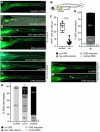A Rapid F0 CRISPR Screen in Zebrafish to Identify Regulator Genes of Neuronal Development in the Enteric Nervous System
- PMID: 40189908
- PMCID: PMC11996052
- DOI: 10.1111/nmo.70009
A Rapid F0 CRISPR Screen in Zebrafish to Identify Regulator Genes of Neuronal Development in the Enteric Nervous System
Abstract
Background: The neural crest-derived enteric nervous system (ENS) provides the intrinsic innervation of the gut with diverse neuronal subtypes and glial cells. The ENS regulates all essential gut functions, such as motility, nutrient uptake, immune response, and microbiota colonization. Deficits in ENS neuron numbers and composition cause debilitating gut dysfunction. Yet, few studies have identified genes that control neuronal differentiation and the generation of the diverse neuronal subtypes in the ENS.
Methods: Utilizing existing CRISPR/Cas9 genome editing technology in zebrafish, we have developed a rapid and scalable screening approach for identifying genes that regulate ENS neurogenesis.
Key results: As a proof-of-concept, F0 guide RNA-injected larvae (F0 crispants) targeting the known ENS regulator genes sox10, ret, or phox2bb phenocopied known ENS phenotypes with high efficiency. We evaluated 10 transcription factor candidate genes as regulators of ENS neurogenesis and function. F0 crispants for five of the tested genes have fewer ENS neurons. Secondary assays in F0 crispants for a subset of the genes that had fewer neurons reveal no effect on enteric progenitor cell migration but differential changes in gut motility.
Conclusions: Our multistep, yet straightforward CRISPR screening approach in zebrafish tests the genetic basis of ENS developmental and disease gene functions that will facilitate the high-throughput evaluation of candidate genes from transcriptomic, genome-wide association, or other ENS-omics studies. Such in vivo ENS F0 crispant screens will contribute to a better understanding of ENS neuronal development regulation in vertebrates and what goes awry in ENS disorders.
Keywords: CRISPR/Cas9; ENS neurons; ENS neuropathies; enteric progenitor cells; intestinal transit.
© 2025 The Author(s). Neurogastroenterology & Motility published by John Wiley & Sons Ltd.
Conflict of interest statement
The authors declare no conflicts of interest.
Figures




Similar articles
-
Molecular fingerprinting delineates progenitor populations in the developing zebrafish enteric nervous system.Dev Dyn. 2016 Nov;245(11):1081-1096. doi: 10.1002/dvdy.24438. Epub 2016 Sep 21. Dev Dyn. 2016. PMID: 27565577 Free PMC article.
-
A targeted CRISPR-Cas9 mediated F0 screen identifies genes involved in establishment of the enteric nervous system.PLoS One. 2024 May 29;19(5):e0303914. doi: 10.1371/journal.pone.0303914. eCollection 2024. PLoS One. 2024. PMID: 38809858 Free PMC article.
-
Neuronal Differentiation in Schwann Cell Lineage Underlies Postnatal Neurogenesis in the Enteric Nervous System.J Neurosci. 2015 Jul 8;35(27):9879-88. doi: 10.1523/JNEUROSCI.1239-15.2015. J Neurosci. 2015. PMID: 26156989 Free PMC article.
-
Gut feelings: Studying enteric nervous system development, function, and disease in the zebrafish model system.Dev Dyn. 2018 Feb;247(2):268-278. doi: 10.1002/dvdy.24597. Epub 2017 Oct 23. Dev Dyn. 2018. PMID: 28975691 Review.
-
Genetic regulation of enteric nervous system development in zebrafish.Biochem Soc Trans. 2024 Feb 28;52(1):177-190. doi: 10.1042/BST20230343. Biochem Soc Trans. 2024. PMID: 38174765 Free PMC article. Review.
References
-
- Furness J. B., The Enteric Nervous System (Blackwell Publishing, 2006).
-
- Olden T., Akhtar T., Beckman S. A., and Wallace K. N., “Differentiation of the Zebrafish Enteric Nervous System and Intestinal Smooth Muscle,” Genesis 46, no. 9 (2008): 484–498. - PubMed
-
- Landman K. A., Simpson M. J., and Newgreen D. F., “Mathematical and Experimental Insights Into the Development of the Enteric Nervous System and Hirschsprung's Disease,” Development, Growth & Differentiation 49, no. 4 (2007): 277–286. - PubMed
-
- Simpson M. J., Zhang D. C., Mariani M., Landman K. A., and Newgreen D. F., “Cell Proliferation Drives Neural Crest Cell Invasion of the Intestine,” Developmental Biology 302, no. 2 (2007): 553–568. - PubMed
-
- Newgreen D. F., Zhang D., Cheeseman B. L., Binder B. J., and Landman K. A., “Differential Clonal Expansion in an Invading Cell Population: Clonal Advantage or Dumb Luck?,” Cells, Tissues, Organs 203, no. 2 (2017): 105–113. - PubMed
MeSH terms
Substances
Grants and funding
LinkOut - more resources
Full Text Sources
Research Materials

